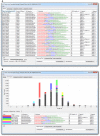Preparing unbiased T-cell receptor and antibody cDNA libraries for the deep next generation sequencing profiling
- PMID: 24391640
- PMCID: PMC3870325
- DOI: 10.3389/fimmu.2013.00456
Preparing unbiased T-cell receptor and antibody cDNA libraries for the deep next generation sequencing profiling
Abstract
High-throughput sequencing has the power to reveal the nature of adaptive immunity as represented by the full complexity of T-cell receptor (TCR) and antibody (IG) repertoires, but is at present severely compromised by the quantitative bias, bottlenecks, and accumulated errors that inevitably occur in the course of library preparation and sequencing. Here we report an optimized protocol for the unbiased preparation of TCR and IG cDNA libraries for high-throughput sequencing, starting from thousands or millions of live cells in an investigated sample. Critical points to control are revealed, along with tips that allow researchers to minimize quantitative bias, accumulated errors, and cross-sample contamination at each stage, and to enhance the subsequent bioinformatic analysis. The protocol is simple, reliable, and can be performed in 1-2 days.
Keywords: BCR repertoires; IG repertoires; MiTCR; NGS applications; T-cell receptor; T-cell receptor repertoire; TCR repertoires; cDNA libraries.
Figures


Similar articles
-
Human B Cell Receptor Repertoire Sequencing.Methods Mol Biol. 2024;2826:31-44. doi: 10.1007/978-1-0716-3950-4_3. Methods Mol Biol. 2024. PMID: 39017883
-
High-Quality Library Preparation for NGS-Based Immunoglobulin Germline Gene Inference and Repertoire Expression Analysis.Front Immunol. 2019 Apr 5;10:660. doi: 10.3389/fimmu.2019.00660. eCollection 2019. Front Immunol. 2019. PMID: 31024532 Free PMC article.
-
Next generation sequencing for TCR repertoire profiling: platform-specific features and correction algorithms.Eur J Immunol. 2012 Nov;42(11):3073-83. doi: 10.1002/eji.201242517. Epub 2012 Sep 24. Eur J Immunol. 2012. PMID: 22806588
-
Describing the diversity of Ag specific receptors in vertebrates: Contribution of repertoire deep sequencing.Dev Comp Immunol. 2017 Oct;75:28-37. doi: 10.1016/j.dci.2017.02.018. Epub 2017 Mar 1. Dev Comp Immunol. 2017. PMID: 28259700 Review.
-
Next-generation sequencing and protein mass spectrometry for the comprehensive analysis of human cellular and serum antibody repertoires.Curr Opin Chem Biol. 2015 Feb;24:112-20. doi: 10.1016/j.cbpa.2014.11.007. Epub 2014 Nov 25. Curr Opin Chem Biol. 2015. PMID: 25461729 Review.
Cited by
-
Deciphering the TCR Repertoire to Solve the COVID-19 Mystery.Trends Pharmacol Sci. 2020 Aug;41(8):518-530. doi: 10.1016/j.tips.2020.06.001. Epub 2020 Jun 20. Trends Pharmacol Sci. 2020. PMID: 32576386 Free PMC article. Review.
-
T cell Repertoire Profiling and the Mechanism by which HLA-B27 Causes Ankylosing Spondylitis.Curr Rheumatol Rep. 2022 Dec;24(12):398-410. doi: 10.1007/s11926-022-01090-6. Epub 2022 Oct 5. Curr Rheumatol Rep. 2022. PMID: 36197645 Free PMC article. Review.
-
T-cell receptor repertoire analysis for the diagnosis and treatment of solid tumor: A methodology and clinical applications.Cancer Commun (Lond). 2020 Oct;40(10):473-483. doi: 10.1002/cac2.12074. Epub 2020 Jul 17. Cancer Commun (Lond). 2020. PMID: 32677768 Free PMC article. Review.
-
The use of non-functional clonotypes as a natural calibrator for quantitative bias correction in adaptive immune receptor repertoire profiling.Elife. 2023 Jan 24;12:e69157. doi: 10.7554/eLife.69157. Elife. 2023. PMID: 36692004 Free PMC article.
-
MAIT cell clonal expansion and TCR repertoire shaping in human volunteers challenged with Salmonella Paratyphi A.Nat Commun. 2018 Jan 17;9(1):253. doi: 10.1038/s41467-017-02540-x. Nat Commun. 2018. PMID: 29343684 Free PMC article.
References
LinkOut - more resources
Full Text Sources
Other Literature Sources

